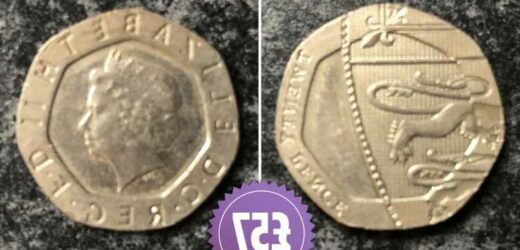A RARE 20p coin that has been minted with an error has sold on eBay for £57 after sparking a bidding war.
The 20p piece was a "mule coin" meaning the design on its "heads" side would not usually go alongside the design featured on its "tails" side.
The eBay seller said the coin was minted in 2008 but the date was missing from the design.
Around 120,000 of these error coins entered circulation in 2008 when the Royal Mint changed the design of the 20p.
It moved the date from the back of the coin to the front next to the Queen's head.
But it made a mistake on a batch of them which were minted without a date at all.
The Royal Mint then accidentally released them into circulation – meaning one of them could have ended up in your purse.
These coins are particularly valuable to collectors as they are the first batch to have made it into circulation without a date for more than 300 years.
Bidding for the 20p started at £30 but it was quickly pushed up to £57 by eager coin collectors.
Coins with mistakes tend to be among the highest valued by collectors because of their extremely limited numbers.
This particular 20p caught the eyes of seven eager bidders looking to add to their collections.
One coin fanatic won the bidding race at the last minute with a £57 offer.
The Royal Mint manufactures between three million and four million coins a day, creating a fairly large opportunity for error.
The Royal Mint will verify your error coins for you, which will let you know if your find is legitimate or not.
It's important to verify the coin's authenticity as you'd be surprised at how many fake coins are in circulation.
The best way to find out if your error coin is genuine
RARE and valuable coins can go for a hefty sum – but how do you know if your coin is the result of a genuine minting error?
The best way to find out if you have an error coin is to send it to the Royal Mint museum, which will analyse it and see if it is a result of a genuine minting error or not.
It'll normally take a couple of weeks to get the results back to you.
But remember, there's a difference between a genuine error coin and one that is just imperfect, for example with a design that is not as clear as you'd expect.
And whatever you do, don't be tempted to splash your cash without evidence from the Mint confirming that it's a genuine error.
Getting an expert to double check the coin will reassure your buyer that they're paying for the real deal – and it could push up the price too.
The 20p mule is not the only coin that has been sold for much more than its cash worth recently.
Last month, a £2 coin with a rare printing error sold on eBay for a huge £138.
A £1 coin minted in 2003 with the same mistake was sold for over £225, while another double-struck pound was sold for £282.
While in February last year, a mis-struck £1 coin which looked like a fried egg sold for £112.
An expert said a rare HG Wells £2 coin with a minting error could be worth up to £1,000.
If you notice your spare change looks different to what it’s supposed to, you might want to keep hold of it and check out how much it could be worth on eBay.
You can also use an online tool called Coin Hunter, which gives you an estimated valuation of your coin based on the average of the most recent sales, as well as a range of how much you can expect it to fetch.
You can also check how much coins previously sold with the same or similar minting error have been sold for on eBay to give you an idea of pricing.
To do this, search the full name of the coin, select the "sold" listing and then toggle the search to "highest value".
It will give you an idea of the amount of money that the coin could go for.
Storage Hunters star Jesse McClure shared his top tip for increasing the value of your spare change.
Here's the rarest and most valuable 10p, 50p and £2 coins – and they could be worth up to £230.
The Royal Mint has launched a new 50p coin featuring Scottish inventor John Logie Baird, and it could be worth up to £500.
Source: Read Full Article



